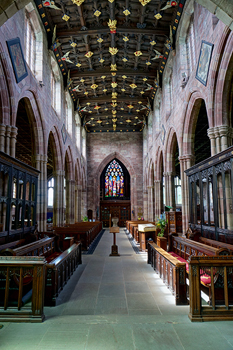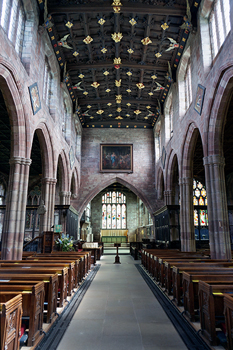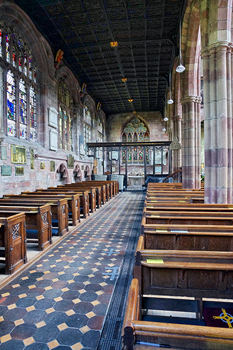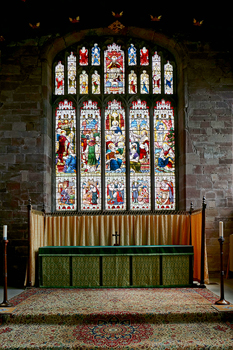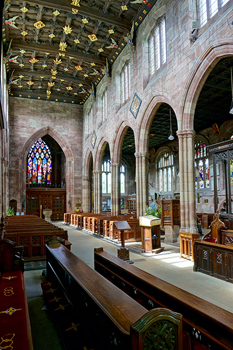MALPAS
Grid Ref: SJ 486 472
9 July 2005 & 16 June 2015
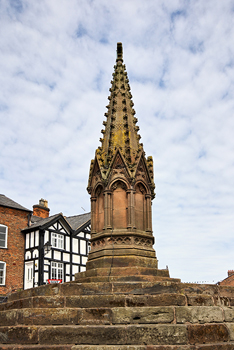 |
|
 |
| Village Cross of 1877 (June 2015) |
|
Malpas Old Infant School, 1745, with wings of 1833 & 1845 |
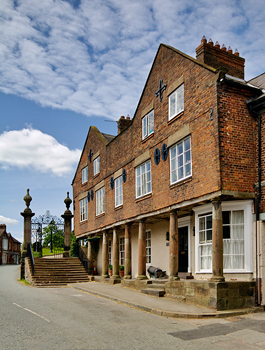 |
|
 |
| Market House with 8 Tuscan columns in 2015 |
|
Jubilee Hall, taken in 2005 |
 |
|
 |
| Timber framed cottage |
|
The Tithe Barn, 2015 |
 |
|
 |
| Timber framed cottage near the church (2015) |
|
Church Gates |
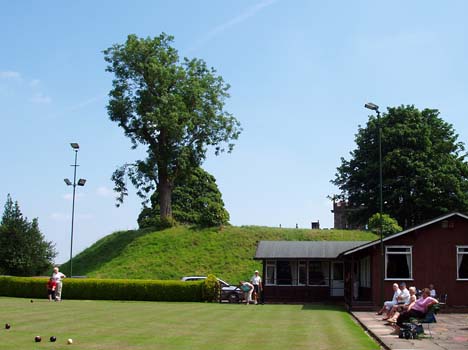 |
|
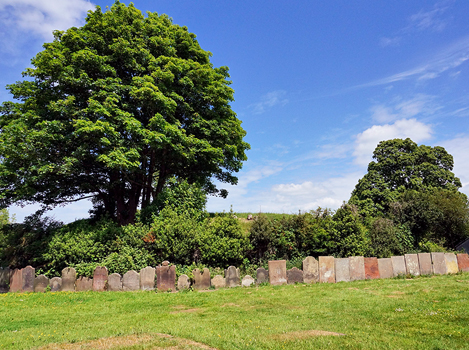 |
| Remains of Motte & Bailey Castle behind the church |
|
View of the Castle site from the churchyard, 2015 |
ST. OSWALD'S CHURCH
 |
| St. Oswald's, June 2015 |
There is an excellent booklet available in the church entitled An Illustrated History of St. Oswald's Malpas, by the Revd. Canon T. M. Rylands, MA, which contains black and white photographs. The brief notes on the church that follow are from this source. The church is dedicated to Oswald, King of Northumbria, killed in battle against Pendra, the King of Mercia in 642. Little is known of who built the church or exactly when. The present church was built in the second half of the 14th century on the site of an earlier one, of which nothing remains. However, there is a list of earlier rectors. Extensive alterations were made in the late 15th century. The roof was removed, the side walls reduced in height and rebuilt with the current windows while the nave arcade was raised to its current height.
The Cholmondeley Chapel at the East end of the North aisle was built by Richard Cholmondeley and his wife Elizabeth in 1514. The Cholmondeley monument, shown in the photograph, was erected in 1605. It shows Sir Hugh Cholmondeley, who died in 1596, and his second wife Mary. The east side of the tomb shows Sir Hugh's son, Sir Hugh the younger and his wife Mary Holford. Sir Hugh the younger was knighted at the time of the Spanish Armada (1588) and was Sheriff of Chester in 1589. The inscription in Latin is translated as follows:
| Hugh Cholmondeley of Cholmondeley the elder, Knight, Vice-Warden of the Welsh Marches, six times Sheriff died in his 83rd year, 1596, and in this earth is buried. Also his son and heir, Hugh Cholmondeley, Knight attaining the age of 50 departed this life AD 1601 and lies here. Also his wife the Lady Mary who after the death of her husband, on account of her very dear affection for him, for love of him had this monument erected AD 1605. |
Richard Cholmondeley the younger, was a benefactor in 1488 and it is known that Sir Randal Brereton gave the tenor bell in 1508. Among the other significant local families were the Dod family of Edge Hall, and the Tarletons of Bolesworth, whose hatchments hang with those of the Cholmondeleys of Cholmondeley Castle in the nave below the clerestory. Following enquiries by Peter Chomley in Melbourne I have examined
several additional sources of information on Sir Hugh Cholmondeley the elder.
Sir Hugh Cholmondeley, sheriff of Cheshire, (born before 1513
and died 6 Jan 1596/97) married first Ann or Amy Dorman in 1540/41. She died
on 18 April 1571. All the children of Sir Hugh are from this marriage. Subsequently,
Sir Hugh married Mary, the daughter of Sir William Griffiths or Gruffydd of
Penrhyn, the widow of Sir Randall Brereton of Malpas and shown in red below.
Sir Hugh the elder died in January 1596/7 (tomb at Malpas) and he was succeeded
by his son, Hugh the younger. Further details are given on the Cholmondeley page.
Other interesting features of the church are the remains of a triple sedilla, seating for additional priests, in the wall near the altar, and a piscina, for washing communion vessels. Most of the box pews of 1680 were destroyed during a restoration in the 1880s but six were preserved in the Brereton Chapel and later moved to the back of the South aisle. There is a fine example of an iron bound parish chest dating from the 13th century. Against the south wall are three 15th century stalls with misericords. There is a two storey porch on the south door. Malpas has some good examples of gargoyles. The guilding on the ceiling was renewed in the 1970s.
Bishop Heber, who wrote some well-known hymns including From Greenland's icy mountains; Holy, Holy, Holy and Brightest and best are the sons of the morning, had a connection with Malpas. He was born in 1775 at the Higher Rectory when his father was rector of the Higher Moiety of the parish. He became Bishop of Calcutta. Scenes from his life are shown in the lower part of the East window.
In the course of my own family history research I examined the records of Marton in Craven in West Yorkshire and found many referencers to the Heber family. For example, Mrs. Mary Heber, wife of the Revd. Reginald Heber B.D. rector of Malpas in Cheshire was buried at Marton in Craven on 10 February 1774. John Heber, clerk and A.M., rector of the Parish of Marton and vicar of Ribchester was buried at Marton in Craven on 3 July 1775. There are also many references to the family in the baptism register. Several of the Hebers were clerics. Bishop Heber's was connected with the Nowell family of Read near Whalley in Lancashire.
At Malpas there is the remains of a motte and bailey castle north of the parish church but there is no evidence for the bailey. Robert FitzHugh, the son of Hugh Lupus is believed to be responsible for the construction, some time before 1100. In the Domesday survey Malpas, then known as Depenbech, was said to have five knights. Malpas had been the centre of an Anglo-Saxon estate and parish and was an important town on the Roman road from Chester to the south. The motte is best seen from behind the church by the bowling green. This is very disappointing when one considers the former excellent state of the site as shown in a photograph in The Castles of Cheshire by P. W. Cullen and R. Hordern, Crossbow Books, 1986.
The Jubilee hall was built for Queen Victoria's Golden Jubilee in 1887. It is on land donated by the Marquis of Cholmondeley and built by public subscription which raised £12,000. It is used as a village hall
THE CHOLMONDLEY TOMB
 |
| Sir Hugh Cholmondeley & his 2nd wife Mary, 1605 |
 |
|
 |
| Details of effigy |
|
The foot of the tomb |
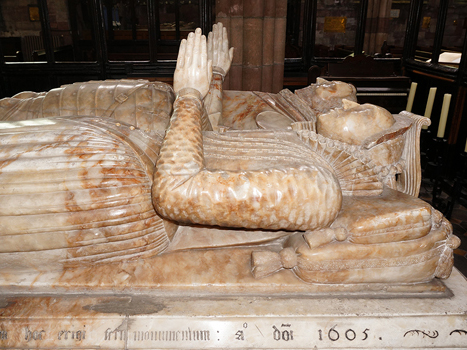 |
|
 |
| Details of effigy |
|
The head of the tomb |
THE BRERTONS OF SHOCKLACH, MALPAS
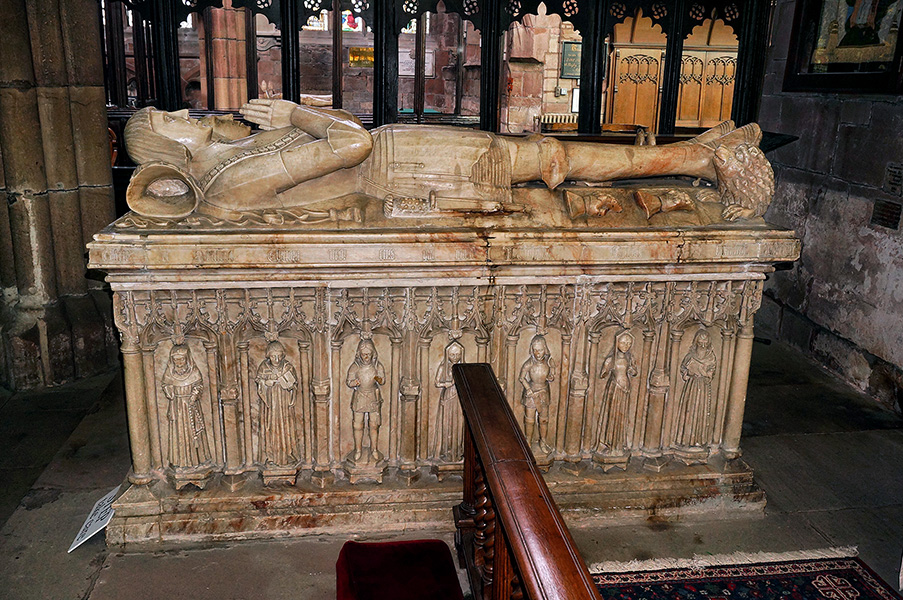 |
| The Brereton Tomb of 1522 in the South Chapel |
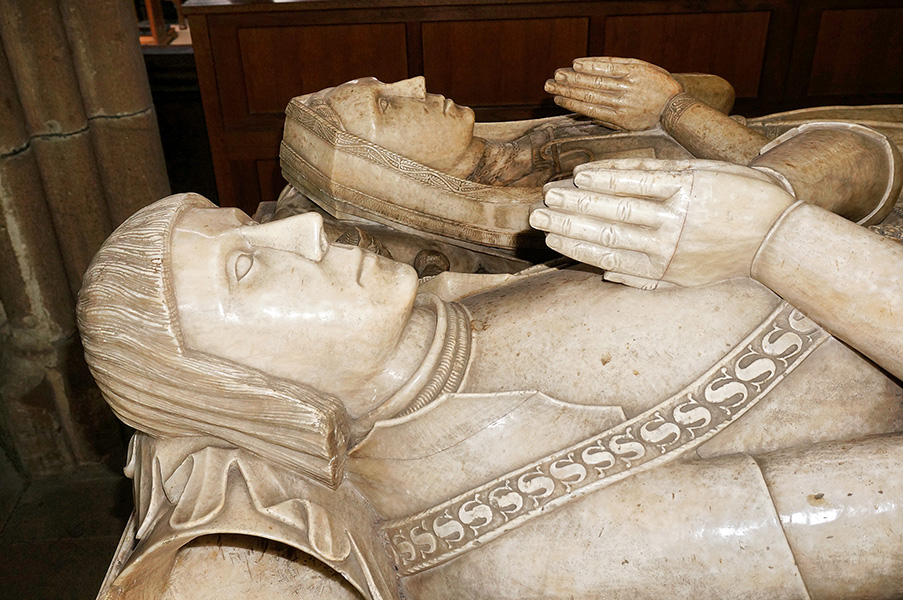 |
| Detail of effigy |
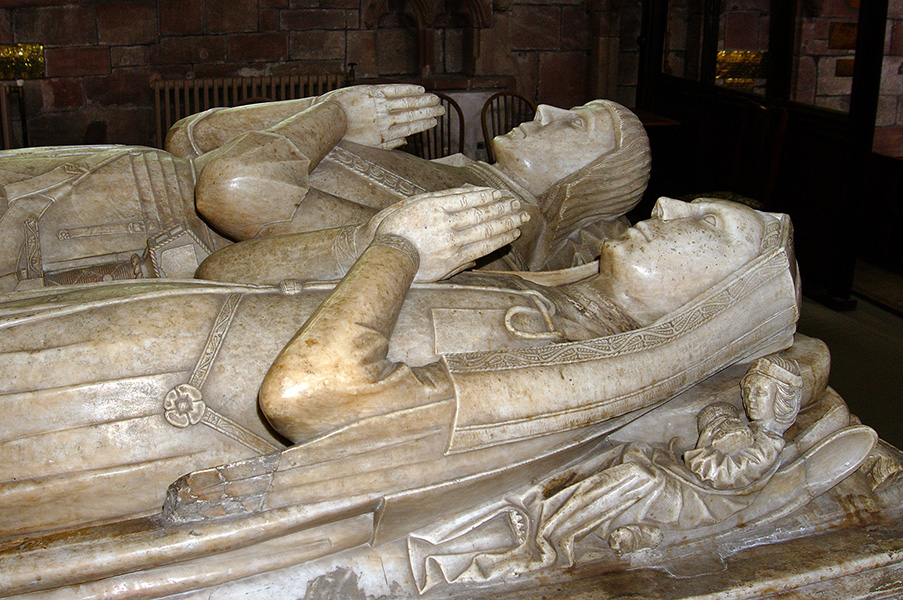 |
| Detail of effigy |
The Brereton Chapel is at the East end of the South aisle. Sir Randal Brereton specified in his will of 1530 that he should be buried in the Lady Chapel so it is presumed that this was on the South side. The Brereton effigy was ordered in Sir Randal's lifetime. As alabaster is not native to Cheshire it is likely to have been made from stone quarried near Burton on Trent. The spurs on the effigy indicate that he was a knight and the dog in the folds of his wife's skirt indicate fidelity. He fought in the battles of Terouanne and Tournay in France and was knight banneret to the body of King Henry VII. His son, was the Sir William Brereton executed by Henry VIII in 1536 on suspicion of being a lover of Anne Boleyn.
In addition there is brass in the East wall of the Brereton chapel, possibly as early as 1362, which states in Norman French "Sir Philip de Egerton, his wives and children lie here, may God have mercy on their souls". An alabaster stone shows a priest and the inscription in Latin "Here lies the body of Urian Davenport, at one time Vicar of Malpas and Vicar of Acton, which said vicar died 28 July AD 1495 on whose soul may the Lord have mercy, Amen."
The Breretons came from Brereton
near Holmes Chapel. In the Domesday Book, the manor of Bretune (Brereton) was
shown as being granted to William Venables, Baron of Kinderton near Middlewich,
who held his barony under Hugh Lupus, Earl of Chester. It is possible that
the Breretons came from France as part of the invasion but the first documentary
evidence for the family comes in 1100 when Ralph de Brereton witnessed a deed
of Gilbert Venables. The earliest person connected to the family tree of the
later Breretons is William de Brereton, living in the late 12th century. In
the reign of Edward III, (1327-77), Sir William Brereton married Ellen, an
heiress and the sister of David Egerton, who became Baron of Malpas. As a
consequence, a branch of the Brereton family became established at Malpas.
Sir William and Ellen had a son, born at Egerton and baptised at Malpas in
1350. He married Anylla, daughter of Sir William Venables at Audlem. Ormerod
states that the original moated Egerton Hall had disappeared by the early
19th century but the chapel remained, and was in use as a barn.
The following family tree, adapted from information in Ormerod,
2nd edition, shows how this branch ran out of male heirs in 1611. However,
through younger sons, it gave rise to the Breretons of Wettenhall, Cuddington,
Shotwick Park and Handforth. In older documents Handforth appears as Honford.
It also shows the Sir William Brereton, a younger son in generation 5, who
was beheaded in the reign of Henry VIII, and in generation 8, Sir William
Brereton of Handforth, the General in the Parliamentary Army.
-
1. Sir Randle Brereton of Malpas,
younger son of Sir William Brereton of Brereton
by his second wife, Margaret, daughter and heiress of Henry Done of Utkinton.
- + Alice daughter and heiress of William Ipstones of Ipstones.
- 2. Randle Brereton of Ipstones
- + 1st wife, Joan daughter of William Holford. It was from this couple
that the Breretons of Wettenhall and the Breretons of Cuddington descended.
- + 2nd wife, Katherine, daughter of Wm. Bulkeley of Eaton
- 3. Randle Brereton of Ipstones
- + Emma, daughter and heiress of John Carrington of Carrington. This
couple had four children of whom we follow only the eldest Randle;
the others were Humphrey, Ellen and Eleanor who married Philip Egerton.
- 4. Sir Randle Brereton of Ipstones, Shocklach, and Malpas, Kt.,
was chamberlain of Chester 1506 to 1532, Knight banneret and knight
of the body of Henry VII. This is the Sir Randle depicted on the
tomb at Malpas. He left nine sons and three daughters. His second
son Sir Richard and his ninth son Sir Urian were the founders
of the Breretons of Tatton and Handforth respectively.
- + Eleanor, daughter of Piers Dutton of Hatton, living 1522,
buried at Malpas.
- 5. Sir Randle Brereton of Shocklach and Malpas.
- + 1st wife Eleanor, daughter of Sir Philip Egerton of Egerton
and Oulton. They had one daughter, Anne the wife of Randal
Dod of Edge.
- + 2nd wife, Isabel daughter of Thos. Butler of Bewsley
- 6. Sir Randle Brereton of Malpas and Shocklach
- + Mary daughter of Sir
William Griffith and Jane the daughter of John Puleston
of Bersham. (Mary later married Sir Hugh Cholmondeley and
their effigies are shown in the picture above.)
- 7. Sir Randle Brereton of Shocklach and Malpas,
Kt., died May 1611.
- + Frances daughter of Sir Robert Throgmorton of
Coghton, Kt.
- 8. Mary Brereton, sole daughter and heiress
baptised at Malpas 9 January 1576 and married
Sir Richard Egerton of Ridley.
- 7. Richard Brereton
- 7. Sir Thomas Brereton, Kt.
- 6. Elizabeth Brereton who married James Starkey of Darley.
- 5. Sir Richard Brereton, Kt., married Jane daughter of Geoffrey
Massey of Tatton, died about 1556.
- 5. John Brereton, rector of both moieties of Malpas and
of Astbury, Bebington and St. Mary's Chester, died in 1542.
- 5. Thomas Brereton, rector of the higher moiety in Malpas,
died 1511.
- 5. Peter Brereton, a priest.
- 5. Sir Roger Brereton, Kt., married Katherine the daughter
of Sir William Brereton of Brereton, widow of Edward Fulleshurst
of Crewe.
- 5.Sir William Brereton, Kt., chamberlain of Chester,
and groom of the chamber to Henry VIII. He married Elizabeth
the daughter of Charles, Earl of Worcester who was the widow
of Sir John Savage and was beheaded 17 May 1536.
- 5. Robert Brereton, living 1566.
- 5. Sir Urian Brereton of Honford (Handforth) Kt., 9th son,
Knighted at Leith on 11 May 1544 and one of the grooms of
the King's chamber in 1541, died about 1577.
- + 1st wife of Sir Urian was Margaret daughter and heiress of Wm. Honford
of Honford (Handforth). This couple had seven sons and two daughter of
whom we follow only the first and second sons, Randle and
William. Four of the sons died in infancy.
- 6. Randle Brereton of Handforth, died without issue
1584
- 6. William Brereton of Handforth, Sheriff of Chester
in 1590 died 1601.
- + Katherine daughter of Roger Hurlestone of Chester.
This couple had four sons and a daughter.
- 7. William Brereton of Handforth, Esq., died 1610.
- + Margaret, daughter and co-heir of Richard Holland
of Denton in Lancashire. This couple had three sons,
William, Richard and Urian and a daughter Margaret.
- 8. Sir William Brereton of Handforth, Parliamentary
General, created baronet
on 10 March 1626/7, died at Croyden, Surrey in
1661.
- +1st wife, Susannah, daughter of Sir George
Booth of Dunham Massey. She died in 1637. This
couple had one son Thomas who married but died
without issue and was buried at Cheadle in 1673/4.
In addition they had three daughters.
- +2nd wife Cicely daughter of William Skeffington
of Fisherwick in Leicester. This couple had one
daughter.
- + 2nd wife of Sir Urian was Alice, daughter of Sir Edmund Trafford. They
had a son Urian and daughters Jane, Mary and Dorothy.
- 3. Ralph Brereton of Iscoyd, had a daugther, Margery who married
John Holford, 1507
- 3. Bartholomew Brereton of Grafton, 3rd son, had sons Bartholomew,
John and Humphrey, none of whom had sons.
- 2. William Brereton of Burros, 2nd son
- + Katherine, daughter and co-heir of Thomas Weild or Wyld of Bhyrros
near Wrexham. This couple led to the Breretons of Shotwick Park.
- 2. Edward Brereton of Burros or Boresham. (Edward's second wife was
Dorothy daughter of Sir Richard Hanmer of Hanmer in Flintshire and the
couple had a son and a daughter
- + 1st wife Elizabeth daughter of John Roden of Burton
Sources
1. The History of the County Palatine and City of Chester,
incorporated with a republication of King's Vale Royal and Leycester's Cheshire
Antiquities, 2nd Ed., revised and enlarged by Thomas Helsby, Esq., published
by George Routledge and sons, Ludgate Hill, London, 1882. This is now available
from the Family History Society of Cheshire on CD ROM. A reprint of the work
was published by Eric Morten of Didsbury.
2. Burke's Peerage, 106th edition, 2003.
3. The House of Commons 1509-1558, by S. T. Bindoff,
Secker and Warburg, London, 1982. This has an article on Sir Hugh Cholmondeley
the elder.
Back to list of families
Introduction to Cheshire Gentry











